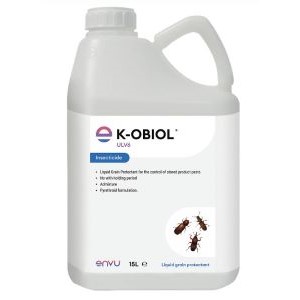What’s lurking beneath? The grain store house of horrors
Grain stores are essential for the preservation of harvests, safeguarding precious crops for market and key in preserving profit for farmers and growers. Yet despite the meticulous attention given to crops from drilling to harvest, the risks and losses associated with poor grain store management are often overlooked.
Grain stores can be a real house of horrors, with 90% of farm grain stores harbouring at least one species of insect known to destroy precious grain. Despite this, it’s a shocking reality that only 40% of growers use an insecticide to treat their grain store, or grain, to prevent devastating infestations from the most common insect pests.
Why Grain is Vulnerable to Infestation
Grain is a living organism, biologically a seed which naturally wants to germinate, sprout and grow. In storage, lack of attention to moisture and temperature can induce germination, spoiling the grain. The careful control of conditions in store is key to keep grain stable, add to this the micro-organisms and insects which are always present to some degree, and the challenge is on to prevent the deterioration and devastating losses that can occur in grain stores.
Unfortunately, the greater the quantity of grain, the greater the risk of infestations. What’s more, where grain is stored flat, or on the floor, the surface in contact with the air is much larger, making the grain more vulnerable to changes in ambient humidity than grain kept in vertical stores.
The Most Unwanted: Insect Pests in Grain Stores
Understanding the origins of grain store pests is an important part in their overall management.
“It’s useful to understand that none of the pests enter the store from the field during the harvest, and if they did, they wouldn’t survive, as they aren’t adapted to survive in the store environment. Instead, grain storage insects lie dormant on ledges or in cracks in the store, they can be brought in on machinery, or on people, or on transport delivering or collecting from the farm,” explains Ken Black, Envu Account Manager.
Insect pests that threaten grain are divided in to three main groups depending on their diet, environment and the behaviour of populations.
Primary insect pests damage the grain while also raising temperature and moisture levels, creating suitable conditions for infestation by secondary insect pests and fungi. These resilient insects are experts at hanging around and originate from residual populations from previously stored grain.
Primary pests include Grain Weevil, Saw-toothed Grain Beetle, Red Rust Grain Beetle, Lesser Grain Borer, and the Rice and Maize Weevil.
Secondary insect pests include the Australian Spider Beetle, stored product moths, Booklice and Fungus Beetles. They develop on grain damaged by primary insects, or from physical or biological action; or on mouldy grain that has been previously infested.
Class three pests include Mites which are much smaller than the insect pests (less than 0.5mm long). They are a serious problem in stored cereals and oilseed rape, causing direct damage and taint. In large numbers they can also cause an allergic reaction in both humans and livestock.
“Understanding the lifecycle of grain store pests is crucial to implementing cost-effective and efficient treatments,” says Ken. “The Envu Grain Protectant Guidebook puts that information at growers’ fingertips, alongside practical advice about how to deal with infestations.”
The Grain Protectant Guidebook provides all the information needed to protect stored harvests. Containing decision tools and information on Integrated Pest Management (IPM), as well as guides on identifying key pests and using insecticide treatment, it’s a free and comprehensive resource for Pest Control Operatives (PCOs), farmers and growers.
How to Banish Problem Pests
Effective pest control in grain stores starts well before the grain arrives. Empty stores can harbour persistent pests from previous harvests who are expert at lying undetected in cracks and crevices, waiting to re-infest incoming grain.
Timely hygiene and thorough cleaning of stores prior to the arrival of grain is vital, but is still not enough in isolation. Effective grain store management relies on IPM.
IPM provides a program of prevention, monitoring and control strategies to limit pest damage by the most economical means possible and with the least environmental impact. A well-planned IPM strategy for grain stores incorporates good hygiene, monitoring, and control with chemical treatments.
The Grain Protectant Guidebook contains decision trees guiding users through the essential preparations needed prior to the arrival of any grain and how to implement an IPM strategy.
After grain arrives, weekly monitoring means any problems are detected early and that control may be possible using a combination of cooling, cleaning, or drying.
“Once grain is in storage, monitoring is essential,” Ken says. “Pit fall traps, insect monitoring traps or nut-free bait bags are all effective ways to assess insect activity. It’s also important to monitor temperature and moisture levels, ideally keeping stores below 13°C and 14.5% moisture for cereals and 7-8% for oilseed rape.”
When it is necessary to consider the use of chemical control, we at Envu offer a choice of options, all developed utilising our vast expertise in agriculture and years of extensive research, development and rigorous testing. This allows us to bring the best possible formulations to the market like K-Obiol™ which has become the reliable, go-to option to remedy insect problems in grain stores.
